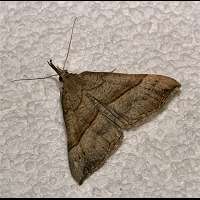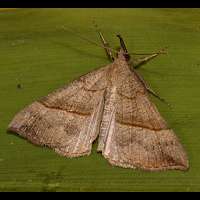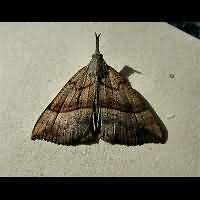Snout Hypena proboscidalis
The Snout is just one of the many Fan-feet and Snouts. And all Fan-feet and Snouts are weird creatures, for they are rather small and don't look like Owlet Moths at all. The snout seems to suggest a Snout Moth. The broad wings, which are kept parallel seem to suggest one of the Geometer Moths, though. All Fan-feet and allies are rather similar. The easiest way of telling them apart is by looking at the lines in the wings, of which there are usually three. The Snout is a big exception to this rule, for it usually shows just two lines. The third line, the lowest, normally is either absent or is represented by a few dots and smears only. Of all Snouts and Fan-feet the Snout has the longest snout by far, hence its name. And the ends of this big snout are nicely curled also. The basic colour is brownish or greyish brownish. The wings end in small hooks pointing outwards. The wingspan is some 38 to 43mm. All these characterisctics mean the Snout is rather unmistakable. By the way the second generations is usually a lot darker and smaller (wingspan varies from 33 to 39mm).
The second generations deposits the eggs in August and September mainly. The caterpillars eat and then hibernate between a rolled up leaf of the foodplant. In early spring they become active again and complete their development. Pupation takes place in May mainly and maybe completed within three weeks. The pupa hangs freely between the leaves of the hostplant. The caterpillar of the Snout is green, long and quite slender. There often is a very vague dark dorsal line. More prominent is the white line across the very small black spiracula. The segments are separated by yellow bands. The head is green with black dots. The caterpillars usually grow to a length of 22 to 26mm. Only one foodplant is known: the Common Nettle.
In most of Britain the Snout has two broods. In the North it has one generation a year only. Where it is double-brooded it is on the wing from the end of May to the beginning of October. There are two clear peaks though: in June and August the numbers are greatest by far. The Snout flies by night only, but it starts flying early in dusk.By day it rests in lower vegetation or the host plant. But it is easily disturbed and flies away quickly. In the evenings often seen on flowers, even those in gardens. The moths are attracted to light and sugar as well. When caught to take pictures you may have a willing model, but you may also be presented with a very impatient animal. The Snout is very unpredictable in this respect. Common species all over Britain, including the Hebrides and Orkney. Very common on the continent as well.
The Snout is just one of the many Fan-feet and Snouts. And all Fan-feet and Snouts are weird creatures, for they are rather small and don't look like Owlet Moths at all. The snout seems to suggest a Snout Moth. The broad wings, which are kept parallel seem to suggest one of the Geometer Moths, though. All Fan-feet and allies are rather similar. The easiest way of telling them apart is by looking at the lines in the wings, of which there are usually three. The Snout is a big exception to this rule, for it usually shows just two lines. The third line, the lowest, normally is either absent or is represented by a few dots and smears only. Of all Snouts and Fan-feet the Snout has the longest snout by far, hence its name. And the ends of this big snout are nicely curled also. The basic colour is brownish or greyish brownish. The wings end in small hooks pointing outwards. The wingspan is some 38 to 43mm. All these characterisctics mean the Snout is rather unmistakable. By the way the second generations is usually a lot darker and smaller (wingspan varies from 33 to 39mm).
The second generations deposits the eggs in August and September mainly. The caterpillars eat and then hibernate between a rolled up leaf of the foodplant. In early spring they become active again and complete their development. Pupation takes place in May mainly and maybe completed within three weeks. The pupa hangs freely between the leaves of the hostplant. The caterpillar of the Snout is green, long and quite slender. There often is a very vague dark dorsal line. More prominent is the white line across the very small black spiracula. The segments are separated by yellow bands. The head is green with black dots. The caterpillars usually grow to a length of 22 to 26mm. Only one foodplant is known: the Common Nettle.
In most of Britain the Snout has two broods. In the North it has one generation a year only. Where it is double-brooded it is on the wing from the end of May to the beginning of October. There are two clear peaks though: in June and August the numbers are greatest by far. The Snout flies by night only, but it starts flying early in dusk.By day it rests in lower vegetation or the host plant. But it is easily disturbed and flies away quickly. In the evenings often seen on flowers, even those in gardens. The moths are attracted to light and sugar as well. When caught to take pictures you may have a willing model, but you may also be presented with a very impatient animal. The Snout is very unpredictable in this respect. Common species all over Britain, including the Hebrides and Orkney. Very common on the continent as well.








